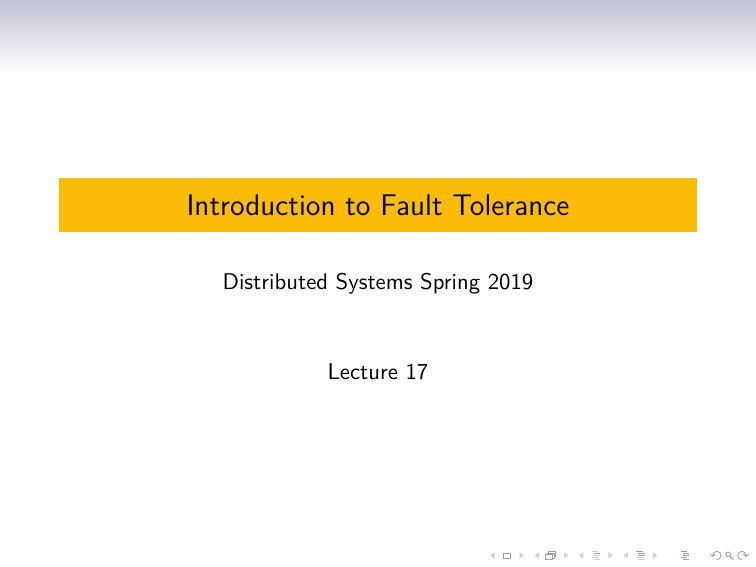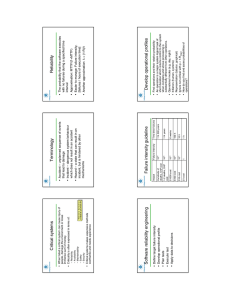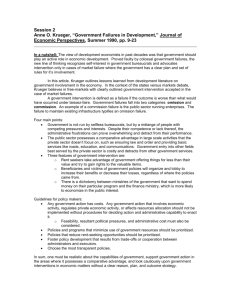
Introduction to Fault Tolerance
Distributed Systems Spring 2019
Lecture 17
Dependability
A component provides services to clients. To provide services,
the component may require the services from other components ⇒
a component may depend on some other component.
Specifically
A component C depends on C ∗ if the correctness of C ’s behavior
depends on the correctness of C ∗ ’s behavior. (Components are
processes or channels.)
Requirements related to dependability
Requirement
Availability
Reliability
Safety
Maintainability
Description
Readiness for usage
Continuity of service delivery
Very low probability of catastrophes
How easy can a failed system be repaired
Reliability Model
•
•
•
•
R(t): Probability of no failures till time t
N: Total number of components
G(t) : Number of good/available components
F(t) : Number of bad/failed components
F (t)
G(t)
=1−
N
N
1 dF (t)
Failure rate: λ(t) =
G(t) dt
dR(t)
1 dF (t)
=−
dt
N dt
Assume a constant failure rate λ(t) = λ
dR(t)
= −λR(t)
dt
R(t) = e −λt
1. R(t) =
2.
3.
4.
5.
6.
Exponential Distributions
• R(t) = e −λt
• Number of failures till time t, F (t) = 1 − R(t) = 1 − e −λt
• This is the CDF of the exponential distribution!
dF (t)
• Probability mass function:
= λe λt
dt
Exponential Distribution
1
CDF λ = 0.5
Probability
0.8
0.6
0.4
0.2
PMF λ = 0.5
0
0
1
2
3
Time
4
5
6
Memoryless property
Exponential distribution frequently used to model inter-arrival
times
• Time between failures, arrivals of requests, busses, . . .
1. Let X be the inter-arrival time with parameter λ
2. Suppose we know that X > t
3. What is P(X > s + t|X > t)
P(X > s + t, X > t)
P(X > t)
P(X > s + t)
5. If X > s + t, then X > t is redundant:
P(X > t)
4. Defn of conditional probability:
e −λ(s+t)
= e −λs
e −λt
7. Conditional probability does not depend on t!
6. Using complementary CDF:
Reliability versus availability
Reliability R(t) of component C
Conditional probability that C has been functioning correctly
during [0, t) given C was functioning correctly at time T = 0.
Traditional metrics
• Mean Time To Failure (MTTF): The average time until a
component fails = 1/λ
• Mean Time To Repair (MTTR): The average time needed
to repair a component.
• Mean Time Between Failures (MTBF): Simply MTTF +
MTTR.
Reliability versus availability
Availability A(t) of component C
Average fraction of time that C has been up-and-running in
interval [0, t).
• Long-term availability A: A(∞)
MTTF
• Note: A = MTTF
MTBF = MTTF +MTTR
Observation
Reliability and availability make sense only if we have an accurate
notion of what a failure actually is.
Failures, errors, and faults
Term
Failure
Error
Fault
Description
A component is not living
up to its specifications
Part of a component that
can lead to a failure
Cause of an error
Example
Crashed program
Programming bug
Sloppy programmer
Handling Faults
Term
Fault prevention
Fault tolerance
Fault removal
Fault forecasting
Description
Prevent the occurrence of a fault
Build a component
such that it can mask
the occurrence of a
fault
Reduce the presence,
number, or seriousness of a fault
Estimate
current
presence,
future
incidence, and consequences of faults
Example
Don’t hire sloppy programmers
Build each component by two independent programmers
Get rid of sloppy programmers
Estimate how a recruiter is doing when
it comes to hiring
sloppy programmers
Failure models
Type
Crash failure
Omission failure
Receive omission
Send omission
Timing failure
Response failure
Value failure
State-transition failure
Arbitrary failure
Description of server’s behavior
Halts, but is working correctly until it
halts
Fails to respond to incoming requests
Fails to receive incoming messages
Fails to send messages
Response lies outside a specified time interval
Response is incorrect
The value of the response is wrong
Deviates from the correct flow of control
May produce arbitrary responses at arbitrary times
Dependability versus security
Omission versus commission
Arbitrary failures are sometimes qualified as malicious. It is better
to make the following distinction:
• Omission failures: a component fails to take an action that
it should have taken
• Commission failure: a component takes an action that it
should not have taken
Observation
Note that deliberate failures, be they omission or commission
failures are typically security problems. Distinguishing between
deliberate failures and unintentional ones is, in general, impossible.
Halting failures
C no longer perceives any activity from C ∗ — a halting failure?
Distinguishing between a crash or omission/timing failure may
be impossible.
Asynchronous versus synchronous systems
• Asynchronous system: no assumptions about process
execution speeds or message delivery times → cannot
reliably detect crash failures.
• Synchronous system: process execution speeds and message
delivery times are bounded → we can reliably detect
omission and timing failures.
• In practice we have partially synchronous systems: most of
the time, we can assume the system to be synchronous, yet
there is no bound on the time that a system is asynchronous
→ can normally reliably detect crash failures.
Halting failures
Assumptions we can make
Halting type
Fail-stop
Fail-noisy
Fail-silent
Fail-safe
Fail-arbitrary
Description
Crash failures, but reliably detectable
Crash failures, eventually reliably detectable
Omission or crash failures: clients cannot
tell what went wrong
Arbitrary, yet benign failures (i.e., they
cannot do any harm)
Arbitrary, with malicious failures
Byzantine Faults
• Presenting different symptoms to different observers
• Most challenging failure mode
• Byzantine Generals Problem: coordinate an attack
• Generals must vote and agree on attack/retreat decision
• Votes are multi-cast (No centralized ballot)
• Trecherous generals can send attack votes to some and retreat
to others
• Agreement reached with majority of non-faulty generals
• For n faulty processes, cannot have agreement with only 3n
processes
•
3 Generals with 1 Traitor
Fault Tolerance Techniques
• Replication. Hard to get consistency
• Checkpointing. Save state periodically and roll-back
• Migration. Requires failure warnings
Distributed Algorithms With Failures
Exercise
Think about behavior of various distributed algorithms in presence
of failures:
• Leader election
• Total Order Multicast




